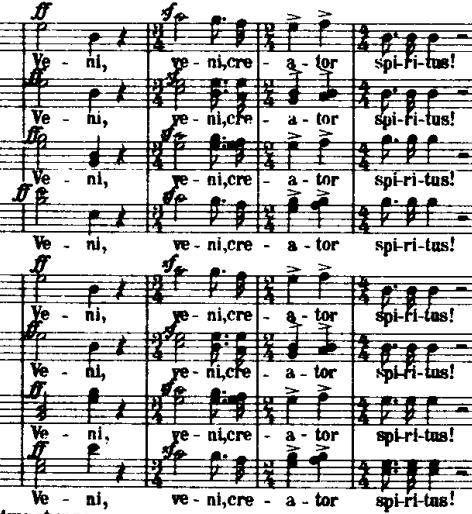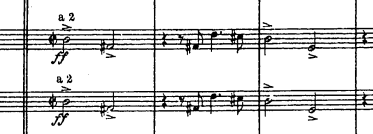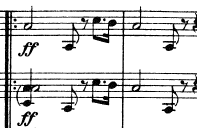Hi Mahler fans.
Following on from last week’s post on Mahler 7, I’ve had a number of questions, challenges and queries which have led to some very illuminating discussions. I thought I’d share a few highlights of those here.
A couple of readers asked what the connection (“to be continued”) is between M7 and M8. Well, it’s a very direct, very blatant one. Remember the final appearance of the main theme of M7:
Then jump ahead to the very beginning of M8
M8 Hauptthema
The similarities of the two themes, both rhythmically and melodically, are pretty obvious. the most telling difference is that in M7 the 3rd note is a leap upward of a 6th to the 3rd scale degree, but in M8 it is a leap of a 7th to the 4th scale degree (I know this is all a little geeky/technical). I think Mahler is telling us that there is a clear kinship between the two works, but that wider interval somehow hints at the underlying sense of ecstasy and aspiration which is the essence of the 8th. Think then about how the 8th ends. The last time the theme returns, Mahler changes the top note:
In this final statement, the leap is further expanded to a 9th- really reaching to the heavens! Or at least to the 6th scale degree. You can see it’s an incredible moment when we finally reach this huge interval after the long journey we’ve been on.
And that journey is even bigger than just the 7th and 8th symphonies. I wrote the other day about some of the thematic relationships between M6 and M7, particularly the use of the “hero” theme from the Finale of M6 in the first mvt of M7.
Henri-Louis de La Grange points out the similarities between the first themes of the opening mvts of M7:
(Main theme of first mvt of M7)
And M6:
(Main theme of 1st mvt of M6)
The similarities are obvious. So- that final statement of the haptthema in M8 actually has it’s origins in the first mvt of M6
One criticism of the work I often hear is that there isn’t enough of a link between the outer and inner mvts of the 7th, that it’s almost like two symphonies. That’s not true. I won’t bore you with all the motivic links that unify the WHOLE symphony, but here is a fun example. See how Mahler takes what musicologists call the “Star Trek” section of the first mvt and changes all those fourths to thirds in the 2nd mvt. The two passages share an almost identical structural function, too- Mahler is using the same material in the same way. How much more of a link could you want?
(Star Trek theme and the next generation)
Also- just as we’ve seen how many connections there are between first mvt of M7 and M6, there are also some very interesting references in the 2nd mvt of the 7th to the parallel mvt of the 6th*. I mentioned the other day how the minor-major progression of the first mvt of M7 acts as a kind of rebuttal to the major-minor shifts which permeate the 6th. However, at the end of the first Nachtmusik, there is a wonderful recycling of the major-minor gesture from the 6th exactly as it appears throughout that work (expect for being in a different key here). Note the similarity of mood, too….
(Ending of 2nd mvt of M7 with reference to M6 and parallel moment in the 2nd mvt of M6)
One could go on and on. Of course, it’s impossible to know how many of these connections had real symbolic significance for Mahler, and how many were simply part of his language. I tend to think the linking between works is an important part of his musical personality.





Recent Comments